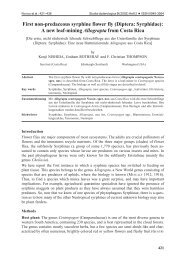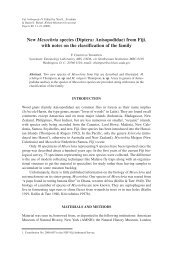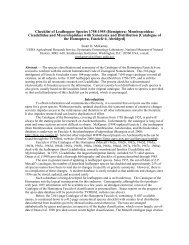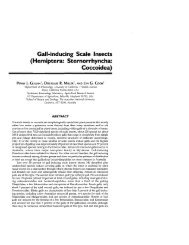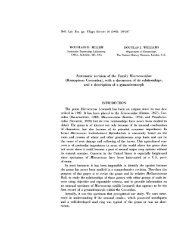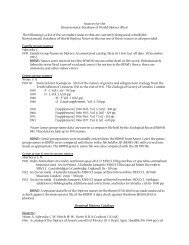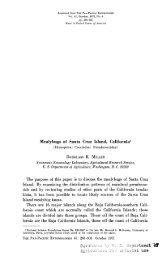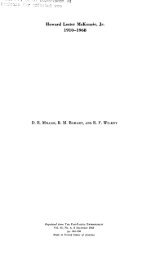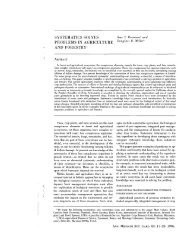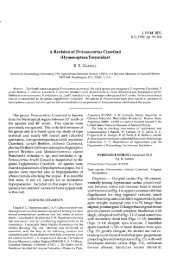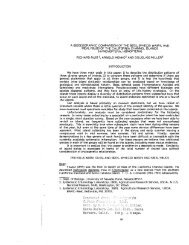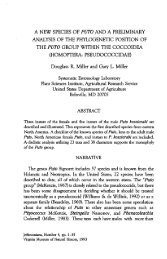Fruit Fly Expert Identification System and Systematic Information
Fruit Fly Expert Identification System and Systematic Information
Fruit Fly Expert Identification System and Systematic Information
You also want an ePaper? Increase the reach of your titles
YUMPU automatically turns print PDFs into web optimized ePapers that Google loves.
Norrbom Status of Knowledge 33<br />
Drew & Hardy (1981), Grewal & Kapoor (1986[1809]), Mainx<br />
(1976), Ponisch & Br<strong>and</strong>l (1992), Liang & Liang (1993),<br />
Hunwattanakul & Baimai (1994), <strong>and</strong> Morgante et al. (1996)<br />
described those of additional species. Most Tephritidae studied<br />
to date have a diploid number of 12 (n=6), although several<br />
species have eight, nine, ten or 14 chromosomes. Within the<br />
family, there is considerable karyotypic variation in centromere<br />
position, secondary constrictions, <strong>and</strong> chromosome size<br />
(Solferini & Morgante 1987).<br />
The sex determination system in Ceratitis capitata has<br />
been reviewed by Lifschitz & Cladera (1989). Maleness is<br />
determined by a small segment of the Y chromosome near the<br />
centromere. In most other tephritids that have been studied, sex<br />
determination systems have been described based on chromosome<br />
morphology only (Berlocher 1993). Male heterogamety<br />
is common in Trypetinae (13 spp. of Anastrepha, 5 spp. of<br />
Bactrocera, Ceratitis capitata, 10 spp. of Rhagoletis, <strong>and</strong> 2 spp.<br />
of Zonosemata) (Frias 1992[1597], Grewal & Kapoor<br />
1986[1809]). Of these species, Anastrepha bistrigata, A. serpentina<br />
<strong>and</strong> Rhagoletis striatella males have been reported as<br />
X1X2Y, whereas R. meigenii may be X0. Two species of<br />
Anastrepha <strong>and</strong> 14 species of Rhagoletis have been reported to<br />
have isomorphic sex chromosomes, although most of the<br />
Rhagoletis are probably male heterogametic except for R.<br />
suavis, which is probably female heterogametic (Berlocher<br />
1993).<br />
Female heterogamety has been reported in some Tephritinae<br />
(a total of 11 species of Cecidocharella, Oedaspis, Procecidochares,<br />
Rachiptera, Acinia, Hyalopeza, Parahyalopeza, <strong>and</strong><br />
Tephritis), whereas Tephritis arnicae has been reported to have<br />
a male XO sex determination system (Bush 1966[682], Frias<br />
1992[1597]). Myopites inulaedyssentericae has heteromorphic<br />
sex chromosomes, but in which sex this occurs has not been<br />
determined (Ponisch & Br<strong>and</strong>l 1992). Six species of Urophora<br />
<strong>and</strong> a total of six species of Dyseuaresta, Trupanea, <strong>and</strong> Trypanaresta<br />
are reported to have isomorphic sex chromosomes<br />
(Mainx 1976, Frias 1992[1597], Ponisch & Br<strong>and</strong>l 1992).<br />
Biochemical <strong>and</strong> molecular studies<br />
Various types of biochemical <strong>and</strong> molecular analyses involving<br />
fruit flies have been conducted, but most were limited<br />
to certain pest species for applied purposes. Most of these data<br />
thus have limited systematic significance at this time. Some<br />
studies have attempted to analyze phylogenetic relationships or<br />
to discriminate taxa using biochemical characters.<br />
Isozyme electrophoresis has been the biochemical technique<br />
most commonly used on tephritids. Rhagoletis is the most<br />
extensively investigated genus (Berlocher 1980, Berlocher &<br />
Bush 1982, Berlocher et al. 1993, Payne & Berlocher<br />
1995[3769]), <strong>and</strong> a key <strong>and</strong> phylogenies have been proposed<br />
based on allozyme data. Gasperi et al. (1991) <strong>and</strong> Kourti et al.<br />
(1992) analyzed the geographic isozyme variability of Ceratitis<br />
capitata <strong>and</strong> its significance regarding the dispersion of this<br />
species. At least some isozymes have been studied in 17 species<br />
of Anastrepha, including A. fraterculus, which is probably a<br />
complex of several cryptic species (Morgante et al. 1980, 1996,<br />
Matioli et al. 1986, Steck 1991, Stefani & Morgante 1996), <strong>and</strong><br />
in 13 species of Bactrocera (McKechnie 1975, Drew & Hardy<br />
1981, Yong 1988, 1990[5250], 1992[5254], 1993, 1995,<br />
Zouros & Loukas 1989, Ooi 1991, Dadour et al. 1992, Drew &<br />
Hancock 1994[1238], Och<strong>and</strong>o et al. 1994), nine species of<br />
Blepharoneura (Condon & Steck, in press), Capparimyia<br />
savastani <strong>and</strong> two species of Ceratitis (Gasperi et al. 1987,<br />
Malacrida et al. 1991, Kourti et al. 1992), Chaetostomella<br />
undosa (Steck 1981), four species of Euaresta (Berlocher<br />
1984[410]), Eurosta solidaginis (Waring et al. 1990), six species<br />
of Neaspilota (Steck 1981), Oxyna parietina (Eber et al.<br />
1992), Paraterellia immaculata (Steck 1981), Tephritis bardanae<br />
(Eber et al. 1991), four species of Terellia (Steck<br />
1981, Muller-Scharer et al. 1991), Trirhithrum coffeae (Malacrida<br />
et al. 1991), <strong>and</strong> Urophora cardui (Eber & Br<strong>and</strong>l 1994).<br />
Simon (1969) used serological techniques to analyze<br />
Rhagoletis pomonella host races <strong>and</strong> R. mendax, <strong>and</strong> Kitto<br />
(1983) <strong>and</strong> Sarma et al. (1987) used immunological techniques<br />
to compare alpha-glycerophosphate dehydrogenase in 16 species<br />
in 12 genera of Tephritidae, but there have been no subsequent<br />
studies of fruit flies using these methods.<br />
DNA research is a rapidly developing area in the study of<br />
Tephritidae as for many other insect groups. Han & McPheron<br />
(1994, 1997) <strong>and</strong> McPheron & Han (1997) studied two DNA<br />
segments; they partially sequenced the nuclear 18S ribosomal<br />
gene of 26 species of fruit flies in 21 genera <strong>and</strong> the mitochondrial<br />
16S ribosomal RNA gene in 50 species in 28 genera. Other<br />
sequences of nuclear <strong>and</strong>/or mitochondrial DNA have been<br />
studied in Anastrepha suspensa <strong>and</strong> fraterculus, seven species<br />
of Bactrocera, Ceratitis capitata, two species of Eurosta, <strong>and</strong><br />
several species of Rhagoletis (Haymer et al. 1990, Anleitner &<br />
Haymer 1992, Soto-Adames et al. 1994, He & Haymer 1994,<br />
Steck & Sheppard 1993, Gasparich et al. 1995, McPheron et al.<br />
1995, Frommer et al. 1996, White 1996, Brown et al. 1996,<br />
Hoeben et al. 1996). Haymer et al. (1994) developed DNA<br />
probes that can be used to distinguish Ceratitis capitata, Bactrocera<br />
cucurbitae <strong>and</strong> B. dorsalis.<br />
Cuticular hydrocarbons have been analyzed in eight species<br />
of Anastrepha, two species of Ceratitis, <strong>and</strong> four species<br />
of Bactrocera, <strong>and</strong> have proven useful to discriminate adults<br />
<strong>and</strong> larvae of these taxa, except among some of the Anastrepha<br />
species (Carlson & Yocum 1986, Goh et al. 1993, Sutton &<br />
Carlson 1993, Sutton & Steck 1994).<br />
Male sex pheromones have been identified, at least partially,<br />
for two species of Anastrepha (Nation 1975, 1989), nine<br />
species of Bactrocera (Koyama 1989[2772], Mazomenos<br />
1989, Perkins et al. 1990), Ceratitis capitata (Jones<br />
1989[2523], Heath et al. 1991), <strong>and</strong> Toxotrypana curvicauda<br />
(Chuman et al. 1987), but there is evidence for their presence<br />
in other species <strong>and</strong> genera. The diverse composition of the<br />
pheromones of the few species studied thus far allows little<br />
generalization. Evidence for host-marking pheromones has<br />
been reported in ten Rhagoletis species, two Anastrepha, Capparimyia<br />
savastani, Ceratitis capitata, Paraceratitella eurycephala,<br />
<strong>and</strong> Tephritis bardanae, but the pheromones have<br />
been identified only in Rhagoletis cerasi (Averill & Prokopy<br />
1989[247], Straw 1989[4692], Freidberg 1990).<br />
Response to certain chemical attractants, such as cue lure,<br />
methyl eugenol, or trimedlure, has been considered taxonomically<br />
useful in the Dacina <strong>and</strong> Ceratitidina (Hancock 1987,<br />
Drew 1989[232]).



